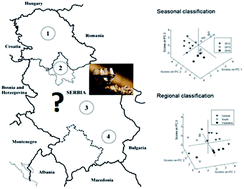Elemental composition as a tool for the assessment of type, seasonal variability, and geographical origin of wine and its contribution to daily elemental intake†
Abstract
The elemental profiles of 63 red and white wine samples from four different regions in Serbia were investigated. Twenty-one elements were analysed (Ca, Mg, Na, K, Fe, Mn, Cu, Zn, Co, Se, Cr, V, Ni, Cd, As, Al, Sb, Pb, Ba, Rb, and Be) by inductively coupled plasma quadrupole mass spectrometry (ICP-Q-MS) and inductively coupled plasma with optical emission spectrometry (ICP-OES). A pattern recognition method was applied in order to classify and differentiate type, seasonal variability, and geographical origin of the wine. Dietary mineral intake for elements was calculated in order to assess their contribution to daily intake. The most important descriptors for discrimination among red and white wine samples were Be, Al, Rb, Mg, K, Cu, Mn, and Na, in descending order. The variables Cd, Pb, As, Sb, V, Na, K, and Zn have the highest influence on vintage-to-vintage classification of red wines. Furthermore, the model revealed the existence of three groups of descriptors for different regions of production. All obtained statistical models confirmed that data from the elemental content of wine samples could be used for accurate prediction of wine type, seasonal variability, and regional origin.



 Please wait while we load your content...
Please wait while we load your content...